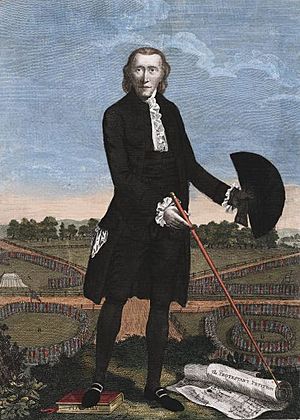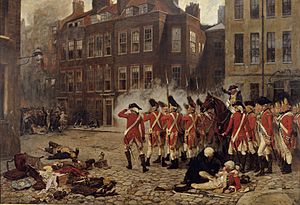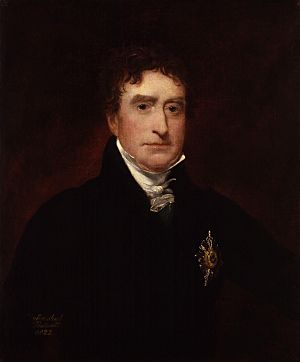Trial of Lord George Gordon facts for kids

The Trial of Lord George Gordon happened on February 5, 1781. It took place in the Court of King's Bench with Lord Mansfield as the judge. Lord George Gordon was accused of a very serious crime called high treason. This was because of his role in the riots that were named after him.
Gordon was the leader of the Protestant Association. He had led a large protest against a new law called the Papists Act 1778. This law aimed to give some rights back to Catholics. Gordon wanted to give a petition to Parliament, but he made the crowd angry by delaying it. He also spoke against Members of Parliament and gave speeches that were against Catholics.
The crowd of protesters then split up and started to loot buildings nearby. By the time the riots ended a week later, about 300 people had died. Gordon was quickly arrested. He was accused of starting a war against the King.
Thomas Erskine and Lloyd Kenyon defended Gordon. The Attorney General, James Wallace, accidentally made some of his own evidence seem silly. Kenyon's speech for Gordon was not very clear or strong. However, Erskine gave a powerful speech. He argued that Gordon's actions were only crimes because of a law called constructive treason, which he said was used incorrectly. The jury agreed and found Gordon not guilty.
People were happy with this decision because many did not like the idea of constructive treason. This made juries less willing to use this extended law. Because of this, the government had to make it a formal written law. Erskine became known as a great lawyer. Gordon, however, was later removed from his church and put in prison. He died in jail in 1793.
What Led to the Trial?

Lord George Gordon was the youngest son of the third Duke of Gordon. He was known for being quite simple in his views about Catholics. He was the leader of the Protestant Association. This group wanted to get rid of the Papists Act 1778. This law was meant to help Roman Catholics.
Before this law, Catholics were not allowed to vote or own land. They could not say mass, work in public office or universities, or serve in the military. However, some of these rules, especially about joining the military, were often ignored. The 1778 Act removed the bans on saying mass, inheriting land, and studying at universities. It also made other changes to encourage Catholics to join the military. This was important because the American Revolution was happening, and Britain needed more soldiers. It was also hoped that helping Catholics would prevent problems in Ireland, which was mostly Catholic.
On June 2, 1780, about 60,000 people met in St George's Fields, London. They were there to hear Gordon speak. He and the crowd planned to give a petition to Parliament against the Papists Act. After marching to Parliament, the crowd became very angry when Gordon said the petition would be delayed. Gordon also encouraged them with speeches against Catholics. He spoke badly about Members of Parliament.
Groups of people then started to destroy and loot Catholic buildings. They also attacked buildings owned by people they thought supported Catholics. Several Members of Parliament were attacked. The home of Lord Chief Justice Lord Mansfield was destroyed. Several prisons were broken into. At least 300 people died during the week it took the military to stop the riots. More property was damaged in this week than in the entire French Revolution. About 450 people were arrested, including Gordon. He was accused of starting a war against the King.
The Trial Begins

Gordon hired two lawyers to defend him: Thomas Erskine and Lloyd Kenyon. The trial began on February 5, 1781, in the Court of King's Bench. Gordon said he was not guilty.
The Attorney General started the case. He accidentally made some of his own witnesses' statements seem silly. Kenyon then spoke for Gordon, but his speech was confusing and not very good. Kenyon was a lawyer who mostly dealt with property law and did not have much experience speaking in public. Seeing how the jury reacted to Kenyon's speech, Erskine asked if he could delay his own speech, and the judge agreed.
After 12 witnesses spoke, saying that Gordon was a good person and loyal to the king, Erskine stood up. Instead of saying Gordon was not involved, Erskine argued that Gordon's actions were not serious enough to be treason. At that time, the law for high treason was based on the Treason Act 1351. This law said that judges could not make the definition of treason wider. However, judges had added a new idea called constructive treason.
Erskine successfully showed that Gordon's goal was only to protect his country, not to harm it. He argued that without the intention to commit treason, no treason could be committed. The original law said an act had to be treasonous by its nature, not just by its result. Gordon's actions, Erskine argued, fell into the second group.
The Solicitor General, James Mansfield, spoke after Erskine. Lord Mansfield, the judge, also gave a summary that was not in Gordon's favor. However, Erskine's strong arguments convinced the jury. They found Lord George Gordon not guilty.
What Happened After the Trial?
Most people were happy with the verdict. Many believed that the idea of constructive treason was a danger to public freedom. Because of this, juries became much less likely to find people guilty of constructive treason. The government then had to change the Treason Act to officially include the idea of constructive treason in written law.
Erskine's speech is seen as the main reason for Gordon being found not guilty. Lloyd Paul Stryker, who wrote a book about Erskine, said that Erskine "held his jury spellbound." He added that Erskine's clear arguments, honesty, and passion made his points very strong.
Erskine later became a very important judge called the Lord Chancellor. He was known as an excellent, though sometimes unusual, lawyer. Kenyon, on the other hand, became the Lord Chief Justice. Gordon, the person on trial, did not have as good a future. He was later removed from his church and sent to prison. He died in jail from typhoid in 1793.

